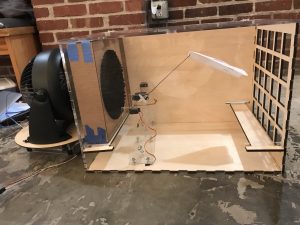Phil Baker and Evan Hill
11/15/17
- Analysis
A. What technical limitations did you discover during the visit?
While at the museum, we discovered that our current combination of fan and flow straightener does not allow the plane to fly well. Flight occurred, but it was relatively weak flight and children were not able to see the true effects of ‘turning’ the plane left and right.
B. In what ways did children and adults find a moment of delight in your project?
When children realized that they were truly able to move the plane up and down, they were immediately excited. They enjoyed seeing their input on the joystick turn into physical output. Adults were excited by the same thing, but even more excited by arduino and wires being visible. To the kids, it was just a thing that happened and was cool. But to the adults, it was amazing to see the physical wiring and board components produce some result from their kids input.
C. What aspects of the observed interactions were surprising to you?
Although the plane was not flying well, the children still enjoyed the exhibit very much. Because some of the children were so young, they were not able to fully grasp the idea of flight via a wind tunnel. They were, however, able to understand that they were causing the motion of the plane.
D. What are additional or different interaction features which would help visitors perceive more of the delight, magic, function, or purpose?
The addition of colorful light effects will most certainly increase the children’s attraction to our installation. We also believe that an autopilot mode will help visitors to enjoy the exhibit more. When untouched for a certain period of time, the plane will begin to fly a pattern on its own. A plane that is already in motion will be much more attractive to children than one that is just sitting static in the tunnel.
E. How does this visit change your vision of the fully realized project?
We no longer are seeking to have children build and test their own planes. We misjudged the age and capabilities of the average visitor. Because of this, we also determined that we will not use IR sensors to monitor the quality of flight.
F. Summary video clip and supporting photos.
2. Revision Plan
A. What will it take to resolve known technical limitations?
We are going to remake the flow straightener so that there is less resistance. We hope to do this via several laser cut sheets layered to create larger tubes. We are also going to change the turning control from the motion of the fan to direct rotation of the plane. We plan to move the servo-controlled rotating base inside the wind tunnel, and we are going to mount the existing plane mount to the rotating base. This will allow children to directly change the height and rotation of the plane. In order to create an ‘autopilot’ mode, we will need to add code that will control the plane while in this mode.
B. How does the fundamental experience need to be modified?
Most children at the museum are too young to make their own functioning plane so we will have a pre-made plane or set of planes that the children can then fly. Instead of focusing on the creation of the plane, the experience will focus on the joy of controlling the plane. The control of the plane captured the children’s attention and created excitement at the museum. We plan to change the control system for the motion of the plane which will make the children’s input easier to observe. The experience has been shifted from creating and testing a plane’s design to a paper airplane flight simulator.
C. What new capability will you add beyond the initial objectives?
We also plan to add lights and an ‘autopilot’ mode to increase visual appeal. The ‘autopilot’ mode will allow for movement even when the wind tunnel is not being used. We are also going to switch to more direct plane control as this seemed to capture the children’s attention.
3. Schedule: https://docs.google.com/a/andrew.cmu.edu/spreadsheets/d/1NIYZ6UjwCsyXJIFSUd4YIChFI9qe8L3xVX5hZD4VVHo/edit?usp=sharing
Leave a Reply
You must be logged in to post a comment.